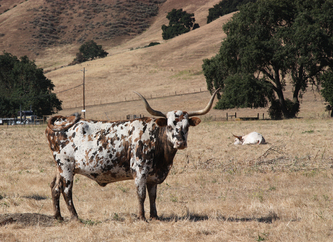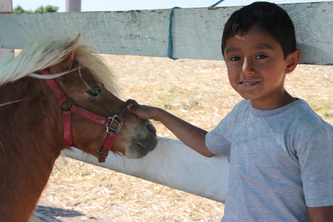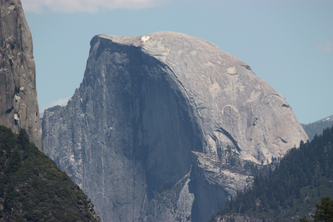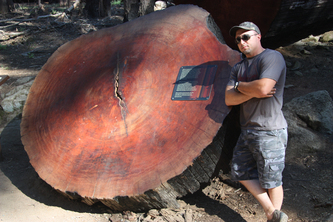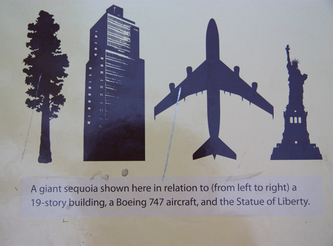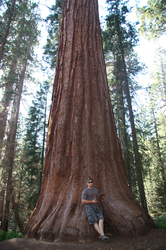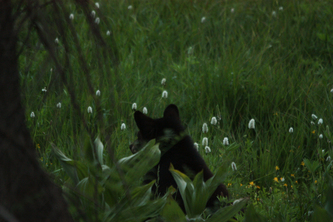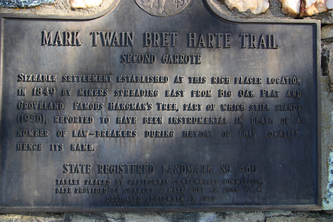getting to Yosemite.....a long way...200 miles through magnifecent countryside
That pic is the full moon at Yosemite...it was huge, this pic does it no justice
TEXAS LONG HORNS JUST OUTSIDE OF YOSEMITE
HEY BROOKE .....LITTLE TINY HORSES ...WE TURNED AROUND AND DROVE BACK TO GET THESE PICS FOR YOU. (NOT EASY ON THESE ROADS WITH THIS 25 FOOT MOTORHOME)
YOSEMITE PINES RV PARK ....well this will be home for two days......and even better they have animals here, and we get to feed them and play with them ...tooooooo cute....wait till you see the pictures of the babies....and the Alpaca's
YOSEMITE NATIONAL PARK
Yosemite National Park embraces almost 1,200 square miles of scenic wild lands set aside in 1890 to preserve a portion of the central Sierra Nevada that stretches along California's eastern flank. The park ranges from 2,000 feet above sea level to more than 13,000 feet and has these major attractions; alpine wilderness, three groves of Giant Sequoias and the glacially carved Yosemite Valley with impressive waterfalls, cliffs and unusual rock formations.
Size - as of 23 Sep 2000
Federal Land - 759,530.26 acres
Non-Federal Land - 1,736.02 acres
Gross Area Acres - 761,266.28
Non-Federal Land - 1,736.02 acres
Gross Area Acres - 761,266.28
Giant Sequoia Groves - The Mariposa Grove, 35 miles south of Yosemite Valley, is the largest of three Sequoia groves in Yosemite. The Tuolumne and Merced Groves are near Crane Flat. Despite human pressures, these towering trees, largest of all living things, have endured for thousands of years. Only in recent years, however, have we begun to understand the Giant Sequoia environment. During the last 100 years protection has sometimes been inadequate and sometimes excessive. For example, in the late 1800s tunnels were cut through two trees in the Mariposa Grove. Conversely, good intentions created another problem, protection from fire has resulted in adverse effects.
Sequoias are wonderfully adapted to fire. The wood and bark are fire-resistant. Black scars on a number of large trees that are still prospering indicate they have survived many scorching fires. Sequoia reproduction also depends on fire. The tiny seeds require minimal soil for germination, and seedlings need sunlight. Historically, frequent natural fires opened the forest, thinned out competing plant species, and left rich mineral soil behind. But years of fire suppression have allowed debris, such as fallen branches, to accumulate, stifling reproduction and allowing shade-tolerant trees to encroach. Prescribed fires, intended to simulate natural fires and improve the health of the forest, are now set by the National Park Service.
As you look at these trees, keep in mind that they have been here since the beginning of history in the western world. The Mariposa Grove's Grizzly Giant is 2,700 years old and is thought to be the oldest of all Sequoias.
Giant Sequoias
The Big Tree is Nature's forest masterpiece and so far as I know, the greatest of living things.
John Muir Although not the oldest living things, a distinction held by the bristlecone pine, giant sequoias are the largest in total volume. Outstanding trees are 2,500 to 3,000 years old, measure up to 35 ft (11 m) in diameter, and tower to heights of 250 to 300 ft (76 m to 91 m) above the ground. Single sequoia limbs may be larger than record-size trees of other species. There seem to be no limits on the trees' growth. Sequoias typically do not die of old age: they usually die by toppling. Is a sequoia a redwood? What is the difference between sequoias and redwoods? The giant sequoia, a member of the redwood family, has a column-like trunk, huge stout branches, and cinnamon-colored bark. Its scientific name is Sequoiadendron giganteum. It is sometimes called the Sierra redwood. The taller more slender coast redwood, Sequoia sempervirens, has the kind of profile and branch structure associated with most conifers. It is named for the color of its heartwood, not its brownish bark. A third species, the dawn redwood, is native to China. Distribution Giant sequoias occur only in about 75 groves scattered between 4,500 and 7,000 ft (1,372 and 2,133 m) in elevation on the west slope of the Sierra Nevada. Some groves containa few trees, others several thousand. The sequoias are not isolated from other trees, but grow in association with white fir, sugar pine, ponderosa pine, and incense-cedar. What makes them stand out from the others is their tremendous size. Fire: rebirth and renewal Near the bases of these giants, the bark may be 12 to 18 inches (30 to 45 cm) thick; however the bark on the limbs is very thin. This soft, fibrous bark is fire resistant and protects the growth layer from periodic fires ignited by lightening. Intense heat generated by the debris accumulated at the tree's base, along with the effect of repeated fires, can breach the bark. However, the tree's water-based sap also enhances the tree's heat tolerance. Burn scars and the blackened, hollow trunks of some older, yet healthy, trees attest to the many fires that have burned through the groves over the centuries. Fire prepares the seed bed by burning off the duff (decomposing bark, needles, and other vegetation) that accumulates on the forest floor. Burning off the duff exposes bare mineral soil, which giant sequoia seedlings need in order to germinate. The park routinely conducts prescribed burns in the sequoia groves in order to mimic the natural cycle of fire. Fires not only bare the soil but also brun off competing smaller species, such as the shade tolerant white fir and incense-cedar. From seeds to saplings Giant sequoias sprout only from seeds--seeds so small and light they resemble flakes of oatmeal. A 1 ounce (30 grams) package would contain about 57,000 seeds. The delicate seeds are procuded in cones that take two years to develop. Although the size of a chicken's egg, each cone contains 200 to 300 seeds. Giant sequoias often retain the green cones alive on the tree for up to 20 or more years. Outside forces, such as fire, insect larvae, and Douglas squirrels, are required to help the tree disperse its seeds. Contact with the ground does not assure the seeds will germinate. Seeds contain little energy, producing a tap root that is not more than one inch (2.5 cm) long. If this tiny root fails to reach mineral soil, it will be unable to transport the nutrients and water necessary to keep the sequoia sprout alive. The maturing sequoia Sequoia saplings grow to their maximum height within several hundred years. At this time, they are conical, like an upside-down ice cream cone. The limbs often grow along the entire length of the trunk. After reaching their maximum height, the trunks begin to grow outward more quickly. The bark thickens, the lower limbs fall off, and the trunk expands to form the shape of a huge column. In addition, the crown of the tree rounds and the large limbs become craggy in appearance as this forest monarch comes of age. Sequoia groves The largest groves and biggest individual sequoias are found in Sequoia and Kings Canyon National Parks, in the southern Sierra Nevada. Many mature sequoias also live exist in Yosemite National Park in three groves: the Mariposa Grove, Tuolumne Grove, and Merced Grove. The Mariposa Grove, the largest of the three groves, is well known for the Grizzly Giant (once thought to be the oldest living sequoia) and the fallen Wawona Tunnel Tree. The Wawona Tunnel Tree became world-famous when an opening was cut through the tree in 1881. For the next 88 years, people came, first in stages and then in automobiles, to ride through this tree. As a result of wet snow, soggy soil, high winds, and perhaps combined with the weakening of the tree from the tunnel, the tree toppled in the winter of 1968/1969. You can still visit this fallen tree, as well as still walk through the California Tunnel Tree (carved out in 1895), near the Grizzly Giant.
The Big Tree is Nature's forest masterpiece and so far as I know, the greatest of living things.
John Muir Although not the oldest living things, a distinction held by the bristlecone pine, giant sequoias are the largest in total volume. Outstanding trees are 2,500 to 3,000 years old, measure up to 35 ft (11 m) in diameter, and tower to heights of 250 to 300 ft (76 m to 91 m) above the ground. Single sequoia limbs may be larger than record-size trees of other species. There seem to be no limits on the trees' growth. Sequoias typically do not die of old age: they usually die by toppling. Is a sequoia a redwood? What is the difference between sequoias and redwoods? The giant sequoia, a member of the redwood family, has a column-like trunk, huge stout branches, and cinnamon-colored bark. Its scientific name is Sequoiadendron giganteum. It is sometimes called the Sierra redwood. The taller more slender coast redwood, Sequoia sempervirens, has the kind of profile and branch structure associated with most conifers. It is named for the color of its heartwood, not its brownish bark. A third species, the dawn redwood, is native to China. Distribution Giant sequoias occur only in about 75 groves scattered between 4,500 and 7,000 ft (1,372 and 2,133 m) in elevation on the west slope of the Sierra Nevada. Some groves containa few trees, others several thousand. The sequoias are not isolated from other trees, but grow in association with white fir, sugar pine, ponderosa pine, and incense-cedar. What makes them stand out from the others is their tremendous size. Fire: rebirth and renewal Near the bases of these giants, the bark may be 12 to 18 inches (30 to 45 cm) thick; however the bark on the limbs is very thin. This soft, fibrous bark is fire resistant and protects the growth layer from periodic fires ignited by lightening. Intense heat generated by the debris accumulated at the tree's base, along with the effect of repeated fires, can breach the bark. However, the tree's water-based sap also enhances the tree's heat tolerance. Burn scars and the blackened, hollow trunks of some older, yet healthy, trees attest to the many fires that have burned through the groves over the centuries. Fire prepares the seed bed by burning off the duff (decomposing bark, needles, and other vegetation) that accumulates on the forest floor. Burning off the duff exposes bare mineral soil, which giant sequoia seedlings need in order to germinate. The park routinely conducts prescribed burns in the sequoia groves in order to mimic the natural cycle of fire. Fires not only bare the soil but also brun off competing smaller species, such as the shade tolerant white fir and incense-cedar. From seeds to saplings Giant sequoias sprout only from seeds--seeds so small and light they resemble flakes of oatmeal. A 1 ounce (30 grams) package would contain about 57,000 seeds. The delicate seeds are procuded in cones that take two years to develop. Although the size of a chicken's egg, each cone contains 200 to 300 seeds. Giant sequoias often retain the green cones alive on the tree for up to 20 or more years. Outside forces, such as fire, insect larvae, and Douglas squirrels, are required to help the tree disperse its seeds. Contact with the ground does not assure the seeds will germinate. Seeds contain little energy, producing a tap root that is not more than one inch (2.5 cm) long. If this tiny root fails to reach mineral soil, it will be unable to transport the nutrients and water necessary to keep the sequoia sprout alive. The maturing sequoia Sequoia saplings grow to their maximum height within several hundred years. At this time, they are conical, like an upside-down ice cream cone. The limbs often grow along the entire length of the trunk. After reaching their maximum height, the trunks begin to grow outward more quickly. The bark thickens, the lower limbs fall off, and the trunk expands to form the shape of a huge column. In addition, the crown of the tree rounds and the large limbs become craggy in appearance as this forest monarch comes of age. Sequoia groves The largest groves and biggest individual sequoias are found in Sequoia and Kings Canyon National Parks, in the southern Sierra Nevada. Many mature sequoias also live exist in Yosemite National Park in three groves: the Mariposa Grove, Tuolumne Grove, and Merced Grove. The Mariposa Grove, the largest of the three groves, is well known for the Grizzly Giant (once thought to be the oldest living sequoia) and the fallen Wawona Tunnel Tree. The Wawona Tunnel Tree became world-famous when an opening was cut through the tree in 1881. For the next 88 years, people came, first in stages and then in automobiles, to ride through this tree. As a result of wet snow, soggy soil, high winds, and perhaps combined with the weakening of the tree from the tunnel, the tree toppled in the winter of 1968/1969. You can still visit this fallen tree, as well as still walk through the California Tunnel Tree (carved out in 1895), near the Grizzly Giant.
We spent the day at Yosemite....it was amazing, 5,000 ft elevation. We saw the brown bear as we were driving in and the small yearling black bear sitting up was seen as we were leaving the park. We got to see the grizzly giant and the bachelor and three ladies. (they are giant sequias) It was amazing to be underneath these trees.....they are bigger than the pictures show. It was impossible to get an entire tree in a shot. I even tried laying on the ground....no luck they are just too big, and if you walk far enough away to be able to get the entire tree in there is another tree in the way or the mountain edge drops off....just not possible to get the shot I desired.
For those who asked what the RV is like on the inside......here you go....and no I did not clean up..... I am on vacation....lol
It is kinda interesting to be able to use a toilet or eat or sleep whenever you feel like it. We do not need to be hooked up for it to work. It has a generator, back up battery and the engine....as well as exterior hook up. The freezer is amazing, we have icecream and we freeze chocolate bars. We eat like kings. We have air conditioning, flat screen tv and dvd player, microwave double sink, lots of storage and a closet. Vas is outside staring a fire to cook some steaks







